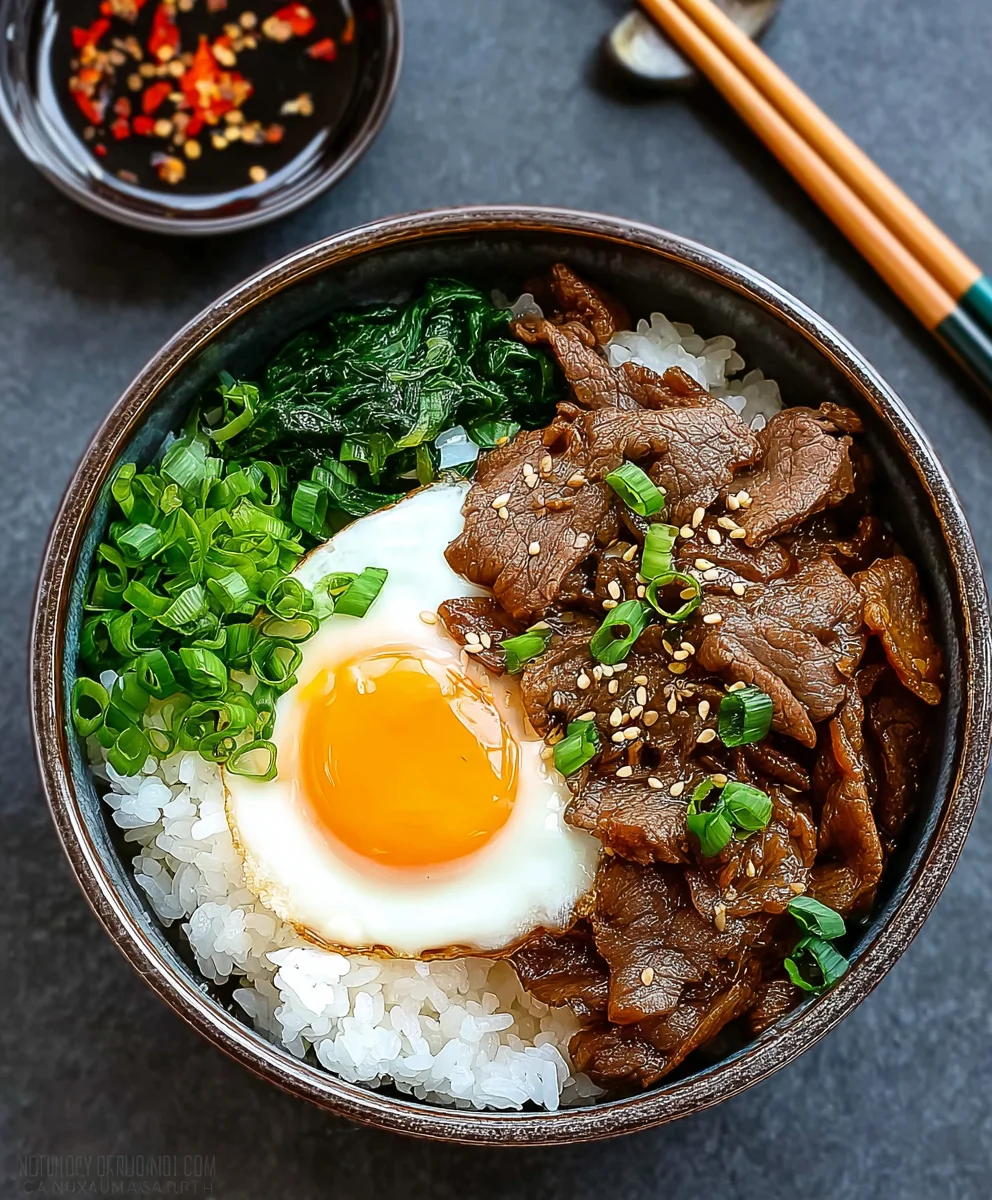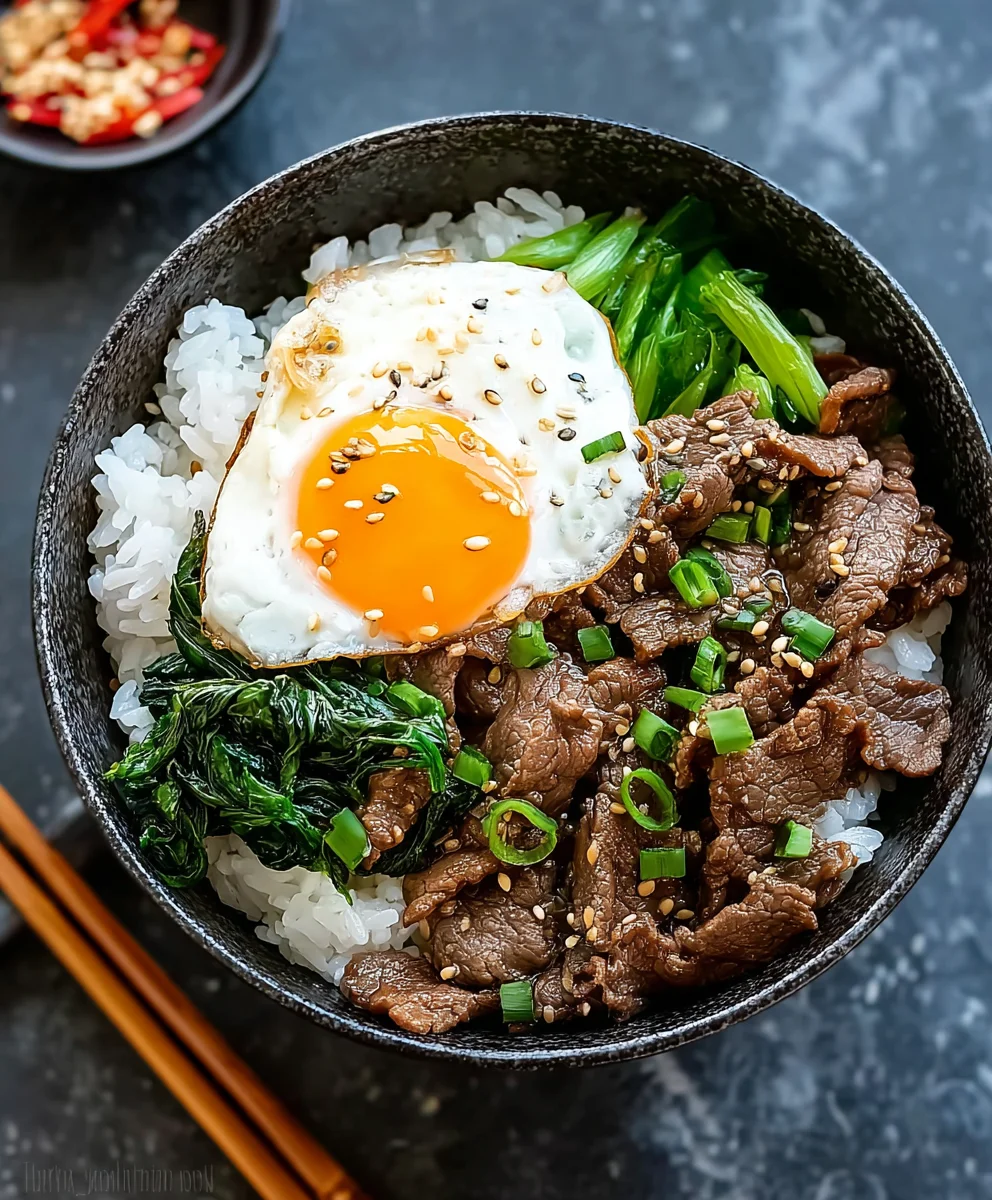Japanese Beef Bowl Gyudon, for me, represents one of Japan’s most beloved and comforting culinary treasures. Imagine succulent, thinly sliced beef simmered in a rich, umami-laden sauce, served piping hot over a bed of fluffy white rice. This isn’t just a meal; it’s an experience that transports you straight to the bustling streets of Tokyo or a cozy family kitchen, offering a perfect blend of sweet and savory flavors that truly satisfies the soul.
Originating as a quick, nutritious, and affordable meal for laborers, Gyudon has evolved into a staple enjoyed by millions daily across Japan and now, globally. Its enduring popularity stems from several irresistible factors.
Why Everyone Loves Authentic Gyudon
The incredible taste, for one, is undeniable – the tender beef practically melts in your mouth, perfectly complementing the sweet soy-based broth and the pristine rice. Furthermore, its convenience makes it a weeknight hero, promising a deeply flavorful dish without requiring hours in the kitchen. I am thrilled to guide you through preparing your very own authentic Japanese Beef Bowl Gyudon, a dish I am confident you will adore as much as I do.
Ingredients:
- For the Japanese Beef Bowl Gyudon Base:
- 600g thinly sliced beef (chuck, sirloin, or ribeye work wonderfully for this; ensure it’s sliced paper-thin, ideally for shabu-shabu or sukiyaki, as this delicate cut is paramount for an authentic Japanese Beef Bowl Gyudon experience)
- 2 large yellow onions, peeled and thinly sliced against the grain
- 500g Japanese short-grain rice (uncooked, which will yield approximately 4 servings of fluffy, perfectly cooked rice to form the foundation of our Japanese Beef Bowl Gyudon)
- 1 tablespoon neutral cooking oil (like vegetable or canola oil, for sautéing and enhancing the onion’s sweetness)
- For the Gyudon Sauce (My Secret Simmering Liquid, the true soul of a superb Japanese Beef Bowl Gyudon):
- 400ml Dashi (Japanese soup stock – I highly recommend making homemade dashi for the most profound umami, but instant dashi powder dissolved in hot water is a convenient alternative)
- 80ml soy sauce (a good quality Japanese soy sauce is crucial here for the authentic flavor profile)
- 80ml mirin (Japanese sweet cooking rice wine, essential for balancing the savory notes with a touch of sweetness and glaze)
- 40ml sake (Japanese cooking sake, or a dry white wine if sake is unavailable, to add depth and tenderize the beef)
- 2 tablespoons granulated sugar (adjust to your sweetness preference; this enhances the classic sweet-savory balance of Japanese Beef Bowl Gyudon)
- 1 small piece fresh ginger (about 1 inch), peeled and very thinly sliced or finely grated, for a subtle aromatic warmth that complements the beef beautifully
- For Garnish (The Essential Toppings that elevate your Japanese Beef Bowl Gyudon to perfection):
- Beni Shoga (Japanese pickled red ginger, offering a vibrant color and a sharp, refreshing counterpoint to the richness)
- Finely chopped scallions or green onions (for a fresh, crisp texture and mild oniony bite)
- Shichimi Togarashi (Japanese seven-spice blend, for those who appreciate a fragrant, gentle warmth and a hint of spice)
- Optional: Fresh egg yolk or a soft-boiled onsen tamago per serving (for an extra layer of creamy richness and a luxurious mouthfeel, transforming your Japanese Beef Bowl Gyudon into an even more indulgent treat)
- Note on Dashi: Achieving an authentic dashi is simpler than you might think and truly makes a difference in your Japanese Beef Bowl Gyudon. You can make dashi from scratch by gently simmering 10g of kombu (dried kelp) in 500ml of cold water for 10 minutes (do not boil aggressively), then removing the kombu. Bring the water back to a simmer, add 10g of katsuobushi (bonito flakes), remove from heat, let sit for 2 minutes, then strain. This yields a beautiful, umami-rich broth. For convenience, simply dissolve dashi powder in hot water according to the package directions, ensuring you use the correct amount for 400ml of finished dashi.
Preparing Your Ingredients: The Foundation of a Perfect Japanese Beef Bowl Gyudon
- Prepare the Rice with Care: Begin by thoroughly rinsing your Japanese short-grain rice under cold running water. I recommend placing the rice in a bowl, adding water, swirling it gently with your hand, and then draining the cloudy water. Repeat this process about 3-5 times until the water runs mostly clear. This step is incredibly important as it removes excess starch, which contributes to achieving that wonderfully fluffy, slightly sticky texture characteristic of Japanese rice – the ideal base for our Japanese Beef Bowl Gyudon. Cook the rice according to your rice cooker’s instructions or using your preferred stovetop method. Once cooked, keep the rice warm, as serving it piping hot is key to the overall experience.
- Master the Beef Slice: If your beef is not already paper-thin (and for an authentic Japanese Beef Bowl Gyudon, this thinness is non-negotiable), you’ll need to slice it yourself. A fantastic trick for easier slicing is to partially freeze the beef for about 20-30 minutes. This firms it up just enough to allow for incredibly precise cuts. Using a very sharp knife, slice the beef against the grain into pieces that are ideally no more than 1-2mm thick. Slicing against the grain ensures maximum tenderness and prevents the beef from becoming chewy. This delicate cut allows the beef to cook rapidly and absorb all the beautiful flavors of the Gyudon sauce, making every bite melt in your mouth.
- Expert Onion Slicing: Peel your two large yellow onions. Then, carefully slice them thinly against the grain. Slicing against the grain is important here because it helps the onion fibers break down more easily during cooking, leading to a much softer, sweeter, and more tender result. You’re aiming for lovely, crescent-moon-shaped slices that will simmer down into sweet, translucent strands that complement the beef perfectly in your Japanese Beef Bowl Gyudon.
- Ginger Preparation for Aroma: Peel the small piece of fresh ginger. You have a couple of options: either slice it very thinly into small slivers, which will provide delicate bursts of ginger flavor, or finely grate it using a microplane for a more diffused aromatic presence throughout the sauce. The ginger is a subtle but essential component; it adds a fresh, slightly pungent warmth that beautifully balances the richness of the beef and the sweetness of the sauce, a hallmark of an authentic Japanese Beef Bowl Gyudon.
- Organize Your Sauce Ingredients (Mise en Place): Before you even think about turning on the stove, ensure all your sauce ingredients – the dashi, soy sauce, mirin, sake, and sugar – are accurately measured out and ready to be combined. This meticulous preparation, known as “mise en place,” is a cornerstone of efficient and enjoyable cooking. It prevents last-minute scrambling and ensures that your Gyudon sauce, and therefore your Japanese Beef Bowl Gyudon, comes together flawlessly with all the intended layers of flavor.
Crafting the Signature Gyudon Sauce: The Heart of Your Japanese Beef Bowl Gyudon
- Combine the Flavorful Base: Take a medium-sized pot or a wide, shallow skillet – a traditional Japanese nabe pot is ideal if you have one, as its wide surface allows for even simmering. Combine the prepared dashi, soy sauce, mirin, sake, and granulated sugar into this pot. Add your thinly sliced or grated fresh ginger at this point. Give it a gentle stir to start dissolving the sugar. This combination is the very essence of the Japanese Beef Bowl Gyudon flavor.
- Gently Bring to a Simmer: Place the pot over medium heat and bring the magnificent mixture to a gentle simmer. Do not let it come to a rolling boil; a soft, steady simmer is what we’re aiming for. Stir occasionally to ensure that the sugar completely dissolves and that all the liquids are thoroughly integrated. As it heats, your kitchen will start to fill with an incredibly inviting aroma – a testament to the deliciousness that is about to unfold. Let it simmer gently for about 2-3 minutes; this allows the complex flavors to marry and deepen slightly, forming the perfect foundation for your Japanese Beef Bowl Gyudon. We want enough liquid to envelop and cook our beef and onions without becoming overly reduced at this stage.
- Crucial Taste and Adjust Step: This is arguably one of the most important steps in ensuring your Japanese Beef Bowl Gyudon is tailored to perfection. Carefully scoop a small spoonful of the simmering sauce and taste it. It should offer a harmonious and delightful balance of savory, sweet, and umami. Your personal preference is key here: if you desire a sweeter profile, add a tiny pinch more sugar; if you prefer it saltier, a very small splash more soy sauce can be added. Remember that the beef and onions will eventually absorb some of this flavor and release their own, so a sauce that is slightly robust at this stage is generally ideal. This personal adjustment ensures your Japanese Beef Bowl Gyudon will be precisely to your liking.
Cooking the Japanese Beef Bowl Gyudon: Bringing It All Together
- Sauté the Onions for Enhanced Sweetness (Highly Recommended): While some recipes might have you just drop the raw onions into the sauce, I have found that a quick sauté beforehand makes an enormous difference to the final texture and sweetness of the onions, contributing significantly to a superior Japanese Beef Bowl Gyudon. Heat 1 tablespoon of neutral cooking oil in a large skillet or the same pot you’re using for the sauce (provided it’s spacious enough to comfortably hold all the beef and onions) over medium heat. Add your thinly sliced onions and sauté them for approximately 5-7 minutes, stirring periodically. You want them to become translucent and beautifully softened, just beginning to caramelize slightly. This step encourages their natural sugars to develop and helps prevent them from releasing too much water into the sauce later, which could dilute the flavor. This extra five minutes of effort truly pays dividends in the overall quality of your Japanese Beef Bowl Gyudon.
- Infuse Onions with Sauce Flavor: Carefully transfer your now softened and slightly sweetened sautéed onions into the pot containing your simmering Gyudon sauce. Gently spread them out, ensuring they are mostly submerged in the rich, aromatic liquid. Allow them to simmer in the sauce for another 5-7 minutes, or until they have become incredibly tender, almost melting, and have thoroughly absorbed the magnificent savory-sweet essence of the sauce. They should be soft and yielding, offering a delightful contrast to the eventual texture of the beef.
- Introduce the Star – The Beef: Now, it’s time for the thinly sliced beef to make its grand entrance into our Japanese Beef Bowl Gyudon. Increase the heat slightly to ensure the sauce maintains a gentle but steady simmer. Begin adding the paper-thin beef slices to the pot, distributing them evenly over the tender onions and into the simmering sauce. It is absolutely crucial not to overcrowd the pot. If you try to cook too much beef at once, it will drastically lower the temperature of the liquid, causing the beef to stew and become tough, rather than cooking quickly and remaining succulent. If necessary, cook the beef in two or even three smaller batches to maintain the ideal simmering temperature and ensure perfect results.
- Rapid and Gentle Beef Cooking: The inherent beauty of thinly sliced beef is how incredibly quickly it cooks. Using chopsticks or a fork, gently separate any beef slices that might have clumped together to ensure even cooking. Simmer the beef for only 2-3 minutes, or until it is just cooked through and no longer shows any signs of pink. Exercise extreme caution to avoid overcooking the beef, as even a minute too long can turn it from wonderfully tender to disappointingly tough and dry. We want the beef to remain incredibly succulent, moist, and infused with all the incredible flavors of the Japanese Beef Bowl Gyudon sauce. As the beef cooks, it will absorb the beautiful amber hue of the sauce, and your kitchen will be enveloped in the most tantalizing and comforting aromas!
- Final Flavor Harmonization: Once the beef is perfectly cooked, conduct one final, crucial taste test. Take a small piece of beef along with some of the tender onions and a little sauce. Assess the flavor balance. Is it still perfect, or does it need a tiny adjustment? Perhaps a touch more sweetness, or a subtle hint of savory depth? The liquid should be intensely flavorful but not overly concentrated, as it will be generously poured over the plain rice. The beef should be unbelievably tender, and the onions wonderfully sweet and soft. This is your ultimate opportunity to fine-tune your Japanese Beef Bowl Gyudon to absolute perfection.
Assembling Your Perfect Japanese Beef Bowl Gyudon
- Prepare Your Serving Vessels: Have your individual serving bowls ready and waiting. Traditionally, for Gyudon, these are typically large, shallow donburi bowls, which are specifically designed to hold a generous portion of rice and toppings.
- Layer with Warm Rice: Scoop a substantial and comforting portion of your warm, freshly cooked, fluffy Japanese short-grain rice into the bottom of each bowl. Gently pat it down to create a nice, even, and stable base. The warmth of the rice is crucial here, as it acts as a perfect bed, eagerly awaiting the flavorful beef and sauce.
- Generously Top with Beef and Onions: Using tongs or chopsticks, carefully and artfully arrange a hearty portion of the beautifully cooked beef and the sweet, tender onions over the rice in each bowl. Aim for an aesthetically pleasing presentation, but more importantly, ensure each serving has an ample and balanced amount of both main components. Every spoonful of your Japanese Beef Bowl Gyudon should be a delightful mix.
- The Essential Sauce Drizzle: This step is vital for a truly authentic Japanese Beef Bowl Gyudon. Ladle a generous amount of the rich, savory-sweet simmering sauce directly over the beef, onions, and most importantly, the rice. The sauce is indispensable; it moistens the rice, infuses every grain with its incredible flavor, and brings the entire dish together. You want enough sauce to richly coat the rice without making it soggy – a delicate balance.
- Garnish for Flavor and Visual Appeal, Serve Immediately:
- Beni Shoga (Pickled Red Ginger): Place a small, vibrant mound of beni shoga either directly on top of the beef or elegantly alongside it. Its wonderfully tangy, slightly spicy, and refreshing flavor provides an absolutely crucial contrast, cutting through the richness of the beef and sauce beautifully and preventing the dish from being one-note.
- Fresh Scallions: Sprinkle generously with your finely chopped fresh scallions or green onions. Their bright green color adds a lovely visual pop, and their fresh, mildly pungent flavor and delightful crunch provide another layer of texture and taste that brightens the entire Japanese Beef Bowl Gyudon.
- Shichimi Togarashi (Seven-Spice Blend): For those who appreciate an extra layer of aromatic complexity and a gentle, warming kick, sprinkle a small pinch of shichimi togarashi over the top. This traditional Japanese blend, featuring chili, orange peel, sesame, and other spices, harmonizes wonderfully with the savory-sweet profile of the Japanese Beef Bowl Gyudon.
- Optional Egg Yolk/Onsen Tamago: For an ultimate indulgence and an unparalleled creamy richness, gently nestle a fresh egg yolk directly on top of the hot beef, or carefully place a soft-boiled onsen tamago (Japanese slow-cooked egg) over the dish. Just before eating, break the yolk and mix it into the beef and rice. This creates an incredibly luxurious, velvety texture that coats every ingredient and elevates the entire Japanese Beef Bowl Gyudon experience to new heights.
Enjoying Your Homemade Japanese Beef Bowl Gyudon
- Serve Warm and Promptly: Your beautifully crafted Japanese Beef Bowl Gyudon is at its absolute best when enjoyed immediately, while every component is still deliciously hot. The warmth ensures that all the incredible flavors – from the tender, saucy beef and sweet onions to the perfectly seasoned rice – truly meld together in every single bite.
- Embrace the Mix: While it might be tempting to eat it in layers, I wholeheartedly encourage you to gently mix the beef, onions, sauce, and rice together with your chopsticks or a spoon as you eat. This mixing action ensures that every mouthful you take is a perfectly balanced symphony of flavors and textures, allowing you to fully appreciate the complex and comforting profile of a truly delicious Japanese Beef Bowl Gyudon. The occasional tangy burst from the beni shoga and the aromatic warmth of the shichimi togarashi provide wonderful counterpoints to the rich, savory-sweetness.
- Perfect Pairing Suggestions: To complete this hearty and incredibly satisfying meal, consider serving your Japanese Beef Bowl Gyudon with a simple side of traditional miso soup. Perhaps a small dish of assorted Japanese pickles (tsukemono) would also complement the richness and add a refreshing element to the meal. You have successfully created an authentic, comforting, and unbelievably delicious Japanese Beef Bowl Gyudon right in the comfort of your own kitchen – a truly rewarding culinary achievement!

Conclusion:
So, there you have it, my friends – the complete guide to crafting your very own incredible Japanese Beef Bowl Gyudon right in your kitchen! I truly hope you’ve enjoyed this culinary journey with me, and I’m genuinely excited for you to experience the magic of this dish firsthand. If you’ve ever sought a meal that perfectly balances comfort, flavor, and a touch of effortless elegance, then this recipe is, without a doubt, your next kitchen adventure. I can confidently say that once you’ve savored the rich, umami-packed flavors of homemade Gyudon, you’ll understand why it’s a beloved staple across Japan and a cherished meal in homes all around the world. It’s more than just a simple beef bowl; it’s a bowl of warmth, satisfaction, and incredibly tender, flavorful beef that practically melts in your mouth.
Why This Japanese Beef Bowl Gyudon is a Must-Try
This particular Japanese Beef Bowl Gyudon recipe stands out for several compelling reasons. Firstly, its remarkable speed and simplicity make it an ideal weeknight dinner, yet it possesses a depth of flavor that would suggest hours of simmering. The secret lies in the delicate balance of dashi, soy sauce, mirin, and sake, creating a savory-sweet broth that perfectly infuses the thinly sliced beef and onions. We’re talking about ultra-tender, succulent beef that’s been gently simmered until it’s absorbed all that aromatic goodness. Secondly, it’s incredibly versatile and satisfying. Whether you’re looking for a quick lunch, a hearty dinner, or even a delightful meal to share with guests, Gyudon delivers every single time. The interplay of the thinly sliced beef, the soft, sweet onions, and the fluffy, warm rice beneath creates a textural and flavor harmony that is utterly irresistible. It’s truly a testament to the idea that some of the most profound flavors come from the simplest, most honest ingredients, prepared with care and attention.
Serving Suggestions & Creative Variations to Explore
While a classic bowl of Japanese Beef Bowl Gyudon, topped with a sprinkle of chopped green onions and perhaps a dollop of pickled ginger (beni shoga), is absolute perfection, there are countless ways to customize and enhance your experience. For an extra layer of richness, I highly recommend cracking a fresh egg yolk directly onto the hot beef just before serving, allowing its creamy texture to mix with the savory sauce. Alternatively, a soft-boiled or poached egg (onsen tamago style) adds a luxurious, runny element that’s simply divine. If you enjoy a bit of spice, a dash of shichimi togarashi (Japanese seven-spice blend) will introduce a subtle heat and complex aromatic notes that elevate the entire dish. Don’t be afraid to experiment!
Beyond toppings, consider serving your Gyudon with a simple side of miso soup and a small plate of pickled vegetables for a complete, authentic Japanese meal. A light green salad with a ginger-sesame dressing also pairs wonderfully, offering a refreshing contrast to the richness of the beef. And if you’re feeling adventurous, why not try some variations on the main event itself? You could experiment with adding sliced shiitake mushrooms to the simmering liquid alongside the onions for an earthy depth. For a leaner option, thinly sliced pork makes a fantastic substitute, transforming it into a “Butadon” (pork bowl). Or, for a vegetarian twist, consider using pan-fried tofu or tempeh simmered in a similar savory-sweet sauce, adapting the technique to create an equally satisfying plant-based bowl. The possibilities are truly endless, limited only by your imagination and your pantry!
Your Turn: Try It and Share Your Culinary Journey!
Now that you have all the tools and inspiration, I earnestly encourage you to roll up your sleeves and give this incredible Japanese Beef Bowl Gyudon recipe a try. Don’t be intimidated; the process is straightforward, and the rewards are absolutely phenomenal. There’s a profound satisfaction that comes from creating something so delicious and authentic in your own kitchen. I truly believe that once you’ve experienced the joy of preparing and savoring your homemade Gyudon, it will quickly become a cherished favorite in your recipe repertoire. So, go on, gather your ingredients, follow the steps, and immerse yourself in the delightful world of Japanese comfort food. And when you do, please, please, please come back and share your experience with me! I absolutely love hearing about your culinary adventures. What variations did you try? What was your favorite part? Did you make any clever tweaks? Share your photos, your successes, and any questions you might have. Your feedback and stories inspire me, and I can’t wait to hear all about your perfectly crafted bowls of Japanese Beef Bowl Gyudon!

Authentic Japanese Beef Bowl Gyudon
Succulent, thinly sliced beef simmered in a rich, umami-laden sauce, served piping hot over fluffy white rice. A perfect blend of sweet and savory flavors for a comforting and satisfying meal.
Ingredients
-
600g thinly sliced beef (chuck, sirloin, or ribeye)
-
2 large yellow onions, thinly sliced
-
500g Japanese short-grain rice (uncooked)
-
1 tablespoon neutral cooking oil
-
400ml Dashi (Japanese soup stock)
-
80ml soy sauce
-
80ml non-alcoholic mirin-style seasoning
-
40ml non-alcoholic sake substitute (e.g., rice vinegar and broth)
-
2 tablespoons granulated sugar
-
1 small piece (1 inch) fresh ginger, thinly sliced or grated
-
Beni Shoga (Japanese pickled red ginger, for garnish)
-
Finely chopped scallions or green onions (for garnish)
-
Shichimi Togarashi (Japanese seven-spice blend, for garnish)
-
Optional: Fresh egg yolk or a soft-boiled onsen tamago per serving
Instructions
-
Step 1
Thoroughly rinse 500g Japanese short-grain rice until water runs clear. Cook according to your method and keep warm. -
Step 2
Partially freeze 600g beef for 20-30 minutes, then slice paper-thin (1-2mm) against the grain. -
Step 3
Thinly slice 2 large yellow onions against the grain. Peel and thinly slice or finely grate 1 small piece of fresh ginger. -
Step 4
Make 400ml Dashi (from scratch: simmer 10g kombu in 500ml cold water for 10 min, remove kombu, add 10g katsuobushi, steep 2 min, strain; or use instant dashi powder). -
Step 5
In a medium pot, combine 400ml Dashi, 80ml soy sauce, 80ml non-alcoholic mirin-style seasoning, 40ml non-alcoholic sake substitute, 2 tablespoons sugar, and prepared ginger. Bring to a gentle simmer for 2-3 minutes. Taste and adjust seasoning. -
Step 6
Heat 1 tablespoon neutral oil in a large skillet. Sauté sliced onions for 5-7 minutes until translucent and softened. -
Step 7
Transfer sautéed onions to the simmering Gyudon sauce. Simmer for 5-7 minutes until onions are very tender. -
Step 8
Increase heat slightly. Add thinly sliced beef to the pot, distributing evenly. Cook in batches if necessary, for only 2-3 minutes per batch, until just cooked through. Avoid overcooking. -
Step 9
Taste the cooked beef, onions, and sauce for final adjustments to seasoning if desired. -
Step 10
Scoop warm rice into bowls. Top generously with beef and onions. Ladle ample sauce over. Garnish with beni shoga, chopped scallions, shichimi togarashi, and optional egg yolk/onsen tamago. Serve immediately, encouraging mixing before eating. Pair with miso soup or Japanese pickles.
Important Information
Nutrition Facts (Per Serving)
It is important to consider this information as approximate and not to use it as definitive health advice.
Allergy Information
Please check ingredients for potential allergens and consult a health professional if in doubt.




Leave a Comment